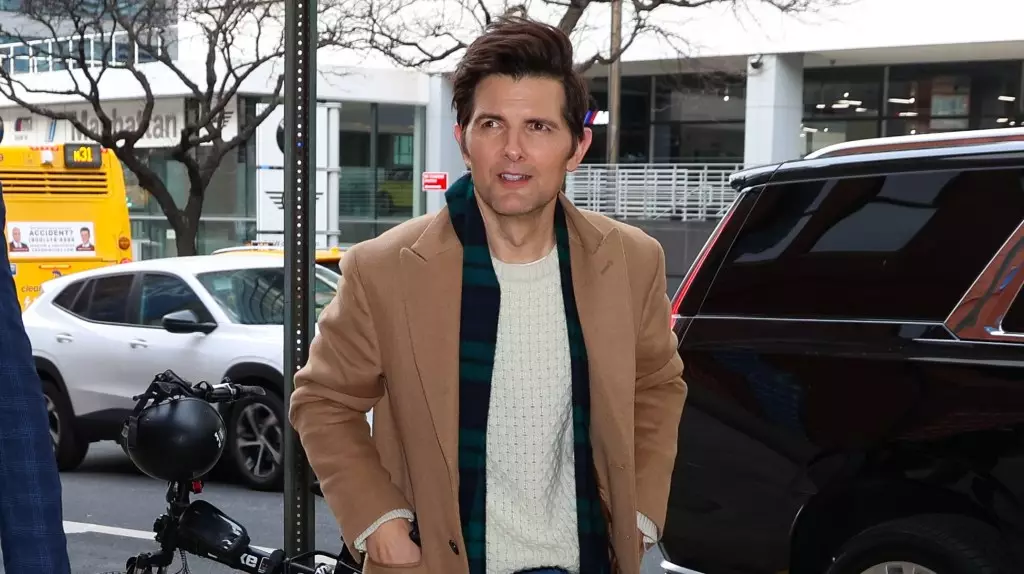In a distinctive blend of reality and fiction, Apple TV+ recently orchestrated a viral marketing event in New York City’s Grand Central Terminal for its much-anticipated series “Severance.” This venture, characterized by its recreation of Lumon Industries’ austere work environment, has raised eyebrows and generated buzz, mirroring the show’s central themes of surveillance and ethical ambiguity in the corporate world. Famed actor Adam Scott, who plays Mark S., engaged in a lively discussion about the experience during an appearance on “The Late Show with Stephen Colbert,” contrasting his enthusiastic demeanor with the darker undertones of his character’s existence.
The marketing stunt took place on January 15, just days before the premiere of Season 2 on January 17, a moment fans had eagerly awaited for nearly three years following a dramatically intense first season conclusion. With Scott at the forefront, joined by fellow cast members like Patricia Arquette and Zach Cherry, the event served as both a promotion and a commentary on the very nature of work—a clever maneuver given the series’ exploration of working-life dualism.
Scott’s portrayal of Mark S. invites a deeper examination of the alienating aspects of corporate life—a relevant subject in today’s landscape full of remote work and tech-driven surveillance. His joyful recounting of the event—spending three hours in a makeshift office with fans observing through glass—illustrates how the show intentionally flips the monotonous office experience on its head, underscoring the absurdity of modern work culture. Scott noted with a chuckle that during this time, the cast members didn’t take bathroom breaks, humorously embracing the often ridiculous nature of office productivity.
What adds to the allure of this event is the context of the show’s premise. “Severance” delves into the lives of employees who have chosen to undergo a procedure that segments their work personalities from their lives outside of work. This marketing pop-up magnified these themes, as it allowed fans to immerse themselves in the very atmosphere depicted on-screen. The reactions of bystanders—gawking, recording videos, and snapping pictures—highlight the surreal interplay between entertainment and reality where people sought enjoyment in observing actors simulate grueling office tasks.
While engaging in the performance, Scott humorously noted that technological hiccups, like his system crashing mid-simulation, forced him to remain in character, offering a glimpse into the challenges of embodying a corporate drone. The event not only encapsulated the spirit of the show but also demonstrated the dedication of the cast to their roles.
Furthermore, Scott’s anecdote about prepping for a pivotal scene in the second season—where he channels the iconic running style of Tom Cruise—takes the discussion beyond mere marketing. The lengthy filming process for this sequence symbolizes the painstaking effort that goes into creating impactful narratives within television. His description of the adjustments he had to make for the physical demands of the scene echoes the broader commitment from the cast and crew to deliver authenticity—even when navigating the practical discomforts of suit-wearing and high-stakes running.
As “Severance” kicks off its second season, the enthusiasm surrounding the marketing campaigns and promotional events underscores the growing cultural significance of the series. The show’s commentary on the juxtaposition of personal identity and corporate expectations resonates with modern audiences, drawing parallels between the fictional narrative and real-world experiences.
The Lumon Industries pop-up and the accompanying discussions offer viewers insight not only into the show itself but into the implications of the workplace environment in today’s world. With “Severance” poised to explore deeper psychological and societal themes within its new season, anticipation mounts. This synergy between promotional tactics and the show’s underlying message makes for a compelling case study in contemporary storytelling and its enveloping effect on audiences. As viewers tune in, the dialogue about work, identity, and morality will undoubtedly continue to expand.

